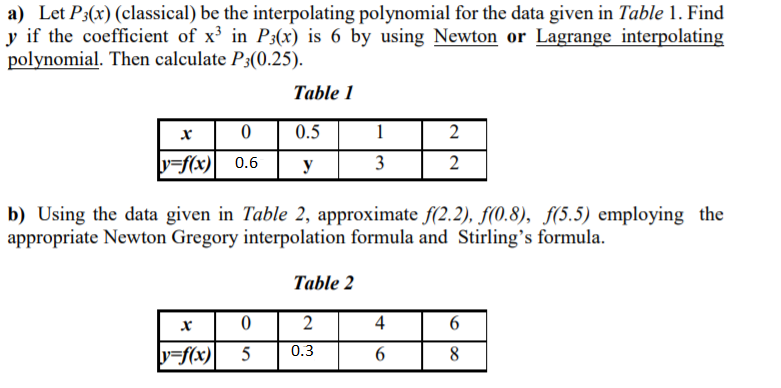a) Let P3(x) (classical) be the interpolating polynomial for the data given in Table 1. Find y if the coefficient of x³ in P3(x) is 6 by using Newton or Lagrange interpolating polynomial. Then calculate P3(0.25). Table 1 0.5 1 y=f(x)| 0.6 y 3 2 2.
a) Let P3(x) (classical) be the interpolating polynomial for the data given in Table 1. Find y if the coefficient of x³ in P3(x) is 6 by using Newton or Lagrange interpolating polynomial. Then calculate P3(0.25). Table 1 0.5 1 y=f(x)| 0.6 y 3 2 2.
Algebra & Trigonometry with Analytic Geometry
13th Edition
ISBN:9781133382119
Author:Swokowski
Publisher:Swokowski
Chapter4: Polynomial And Rational Functions
Section4.3: Zeros Of Polynomials
Problem 66E
Related questions
Question

Transcribed Image Text:a) Let P3(x) (classical) be the interpolating polynomial for the data given in Table 1. Find
y if the coefficient of x in P3(x) is 6 by using Newton or Lagrange interpolating
polynomial. Then calculate P3(0.25).
Table 1
0.5
1
2
y=f(x) 0.6
y
3
b) Using the data given in Table 2, approximate f(2.2), f(0.8), f(5.5) employing the
appropriate Newton Gregory interpolation formula and Stirling's formula.
Table 2
2
4
0.3
y=f(x)
5
8
Expert Solution
This question has been solved!
Explore an expertly crafted, step-by-step solution for a thorough understanding of key concepts.
Step by step
Solved in 3 steps with 2 images

Knowledge Booster
Learn more about
Need a deep-dive on the concept behind this application? Look no further. Learn more about this topic, advanced-math and related others by exploring similar questions and additional content below.Recommended textbooks for you

Algebra & Trigonometry with Analytic Geometry
Algebra
ISBN:
9781133382119
Author:
Swokowski
Publisher:
Cengage

College Algebra
Algebra
ISBN:
9781305115545
Author:
James Stewart, Lothar Redlin, Saleem Watson
Publisher:
Cengage Learning

Algebra & Trigonometry with Analytic Geometry
Algebra
ISBN:
9781133382119
Author:
Swokowski
Publisher:
Cengage

College Algebra
Algebra
ISBN:
9781305115545
Author:
James Stewart, Lothar Redlin, Saleem Watson
Publisher:
Cengage Learning